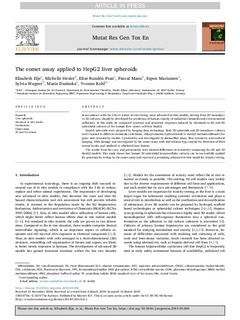| dc.contributor.author | Elje, Elisabeth | |
| dc.contributor.author | Hesler, Michelle | |
| dc.contributor.author | Rundén-Pran, Elise | |
| dc.contributor.author | Mann, Pascal | |
| dc.contributor.author | Mariussen, Espen | |
| dc.contributor.author | Wagner, Sylvia | |
| dc.contributor.author | Dusinska, Maria | |
| dc.contributor.author | Kohl, Yvonne | |
| dc.date.accessioned | 2019-04-12T07:44:22Z | |
| dc.date.available | 2019-04-12T07:44:22Z | |
| dc.date.created | 2019-04-02T08:37:15Z | |
| dc.date.issued | 2019 | |
| dc.identifier.issn | 1383-5718 | |
| dc.identifier.uri | http://hdl.handle.net/11250/2594383 | |
| dc.description.abstract | In accordance with the 3 Rs to reduce in vivo testing, more advanced in vitro models, moving from 2D monolayer to 3D cultures, should be developed for prediction of human toxicity of industrial chemicals and environmental pollutants. In this study we compared cytotoxic and genotoxic responses induced by chemicals in 2D and 3D spheroidal cultures of the human liver cancer cell line HepG2. HepG2 spheroids were prepared by hanging drop technology. Both 3D spheroids and 2D monolayer cultures were exposed to different chemicals (colchicine, chlorpromazine hydrochloride or methyl methanesulfonate) for geno- and cytotoxicity studies. Cytotoxicity was investigated by alamarBlue assay, flow cytometry and confocal imaging. DNA damage was investigated by the comet assay with and without Fpg enzyme for detection of DNA strand breaks and oxidized or alkylated base lesions. The results from the cyto- and genotoxicity tests showed differences in sensitivity comparing the 2D and 3D HepG2 models. This study shows that human 3D spheroidal hepatocellular cultures can be successfully applied for genotoxicity testing by the comet assay and represent a promising advanced in vitro model for toxicity testing. | nb_NO |
| dc.language.iso | eng | nb_NO |
| dc.rights | Attribution-NonCommercial-NoDerivatives 4.0 Internasjonal | * |
| dc.rights.uri | http://creativecommons.org/licenses/by-nc-nd/4.0/deed.no | * |
| dc.title | The comet assay applied to HepG2 liver spheroids | nb_NO |
| dc.type | Journal article | nb_NO |
| dc.type | Peer reviewed | nb_NO |
| dc.description.version | acceptedVersion | nb_NO |
| dc.rights.holder | © 2019 The Authors. Published by Elsevier B.V. | nb_NO |
| dc.source.journal | Mutation research. Genetic toxicology and environmental mutagenesis | nb_NO |
| dc.identifier.doi | 10.1016/j.mrgentox.2019.03.006 | |
| dc.identifier.cristin | 1689623 | |
| dc.relation.project | EC/H2020/685817 | nb_NO |
| dc.relation.project | Norges forskningsråd: 272412 | nb_NO |
| dc.relation.project | COST (European Cooperation in Science and Technology): CA15132 | nb_NO |
| cristin.unitcode | 7460,60,0,0 | |
| cristin.unitname | Miljøkjemi | |
| cristin.ispublished | false | |
| cristin.fulltext | postprint | |
| cristin.qualitycode | 1 | |

